Diagnostic Protocol for Thermal Performance of District Heating Pipes in Operation. Part 2: Estimation of Present Thermal Conductivity in Aged Pipe Insulation
Abstract
:1. Introduction
2. Improvements in the New Measurement Set-Up
3. Potential Use of Shutdown Valve Measurements
3.1. Mathematical Model of an Optimal Case (No Transverse Heat Losses)
3.2. Results of Field Test Measurements
3.3. Simulation Model Compared with Measurements
4. Potential Use of Drainage Valve Measurements
4.1. Mathematical Convection Model
4.2. Results of Field Test Measurements
5. Determination of Thermal Conductivity Using Drainage Valve
5.1. Soil Temperature at Casing Pipe
5.2. Resulting Thermal Conductivity in the DH Pipe
6. Suggested Method for Assessing the Thermal Performance of PUR Insulation
- An accessible manhole with a shutdown valve for turning the flow off and on.
- At least one measurable drainage valve accessible through a manhole in the assessed part of the network. The drainage valve should be insulated with at least hat insulation (see Section 2). Installing the manhole set-up and starting recording with the temperature logger should be performed at least 2 h before the shutdown.
- The DH network under assessment should be shut down for at least 2 h for pipe dimensions up to DN200 and for at least 8 h for pipe dimensions up to DN500. The required shutdown time can be adequately estimated by dividing the nominal diameter (DN) by 60, i.e., DN500/60 = 8.3 h.
- The cooling method is assessed to have a margin of error of less than 5% if estimates of the following parameters are known: thermal conductivity of the soil (rough estimate), supply temperature data from nearby customers, pipe depth from soil surface, and seasonal air temperature variations on location.
7. Conclusions
Author Contributions
Funding
Conflicts of Interest
References
- Fredriksen, S.; Werner, S. District Heating and Cooling, 1st ed.; Studentliteratur AB: Lund, Sweden, 2013. [Google Scholar]
- Berge, A.; Adl-Zarrabi, B.; Hagentoft, C.-E. Assessing the Thermal Performance of District Heating Twin Pipes with Vacuum Insulation Panels. Energy Procedia 2015, 78, 382–387. [Google Scholar] [CrossRef] [Green Version]
- Zwierzchowski, R.; Niemyjski, O. Simulation of Heat Losses of a Distribution Network with Different Technical Structure and under Different Operating Conditions for a District Heating and Cooling System. IOP Conf. Ser. Mater. Sci. Eng. 2019, 603, 032091. [Google Scholar] [CrossRef]
- Danielewicz, J.; Śniechowska, B.; Sayegh, M.A.; Fidorów, N.; Jouhara, H. Three-dimensional numerical model of heat losses from district heating network pre-insulated pipes buried in the ground. Energy 2016, 108, 172–184. [Google Scholar] [CrossRef] [Green Version]
- Chicherin, S.; Mašatin, V.; Siirde, A.; Volkova, A. Method for Assessing Heat Loss in A District Heating Network with A Focus on the State of Insulation and Actual Demand for Useful Energy. Energies 2020, 13, 4505. [Google Scholar] [CrossRef]
- Wang, H.; Meng, H.; Zhu, T. New model for onsite heat loss state estimation of general district heating network with hourly measurements. Energy Convers. Manag. 2018, 157, 71–85. [Google Scholar] [CrossRef]
- Lidén, H.P.; Adl-Zarrabi, B. Non Destructive Methods of District Heating Pipes. In Proceedings of the 12th ECNDT, Gothenburg, Sweden, 10–19 June 2018. [Google Scholar]
- Lidén, H.P.; Adl-Zarrabi, B. Development of a Non-destructive Testing Method for Assessing Thermal Status of District Heating Pipes. J. Nondestruct. Eval. 2020, 39, 22. [Google Scholar] [CrossRef] [Green Version]
- Lidén, P.; Adl-Zarrabi, B. Non-Destructive Methods for Assessment of District Heating Pipes: A Pre Study for Selection of Proper Method. In Proceedings of the 15th International Symposium on District Heating and Cooling, Seoul, Korea, 4–7 September 2016. [Google Scholar]
- Lidén, H.P.; Adl-Zarrabi, B.; Hagentoft, C.E. Diagnostic Protocol for Thermal Performance of District Heating Pipes in Operation. Part 1: Estimation of Supply Pipe Temperature by Measuring Temperature at Valves after Shutdown. Energies 2021, 14, 5192. [Google Scholar] [CrossRef]
- Fjellborg, F. Data Received from Borås Energy; Borås Energy: Borås, Sweden, 2021. [Google Scholar]
- Miller, D. Advances in Heat Transfer; Irvine, T.F., Jr., Hartnett, J.P., Eds.; Academic Press: New York, NY, USA, 1964; Volume 1, p. 459. [Google Scholar] [CrossRef]
- MathWorks. Available online: https://www.mathworks.com/help/matlab/ref/ode15s.html (accessed on 16 August 2021).
- Hagentoft, C.E. Introduction to Building Physics; Ligthning Source: Lund, Sweden, 2001. [Google Scholar]
- Swedish Meteorological and Hydrological Institute. Available online: www.smhi.com (accessed on 16 August 2021).
- SS-EN13941. Design and Installation of Preinsulated Bonded Pipe Systems for District Heating; Swedish Standards Institute: Stockholm, Sweden, 2009. [Google Scholar]
- Claesson, J.D.A. Heat Extraction from the Ground by Horizontal Pipes—A Mathematical Analysis; Sweden, L., Ed.; Department of Mathematical Physics, Swedish Counsil for Building Research: Stockholm, Sweden, 1983; Volume D1. [Google Scholar]
- Powerpipe. Product Catalog; 2018; Available online: www.Powerpipe.se (accessed on 4 February 2021).
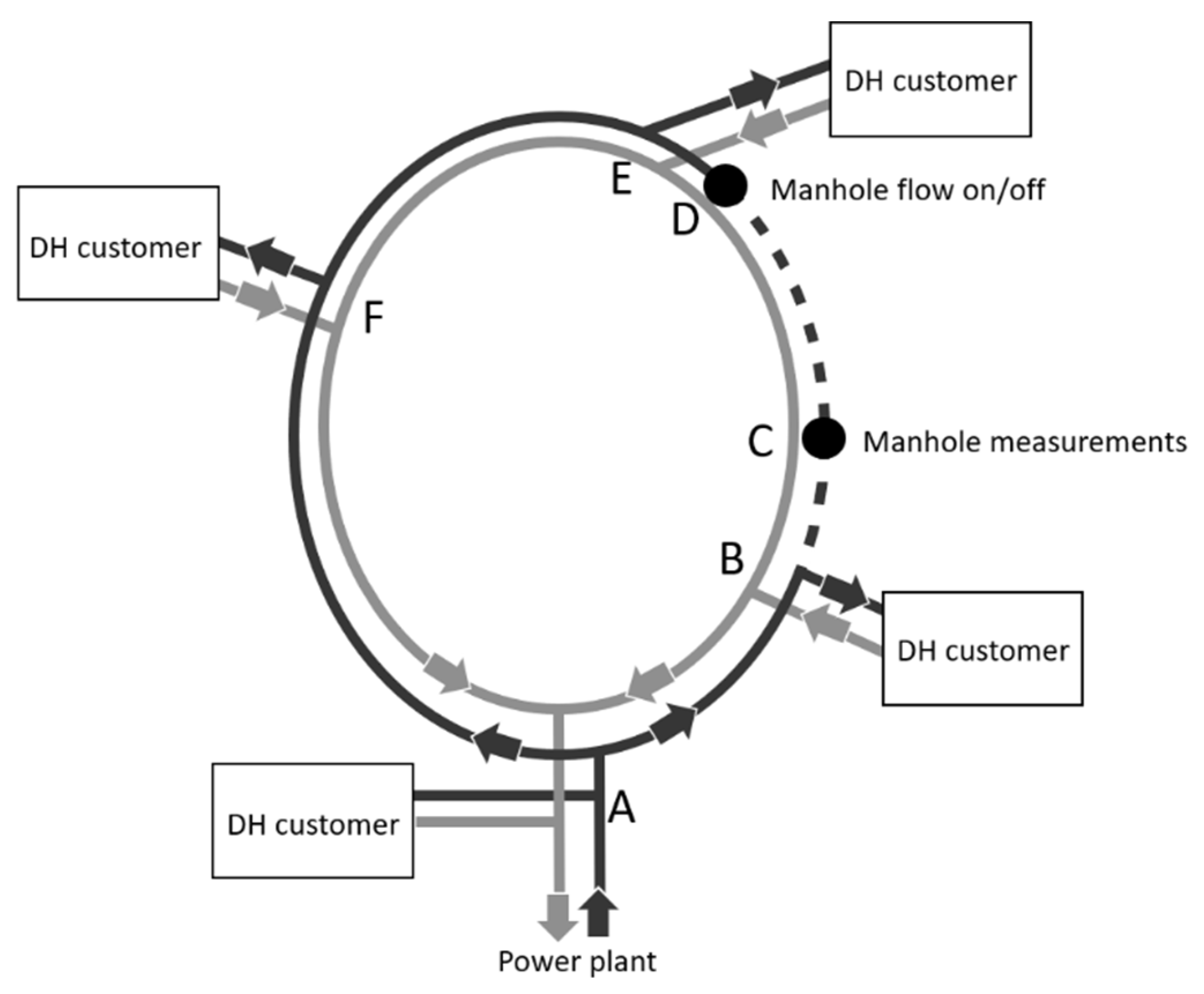

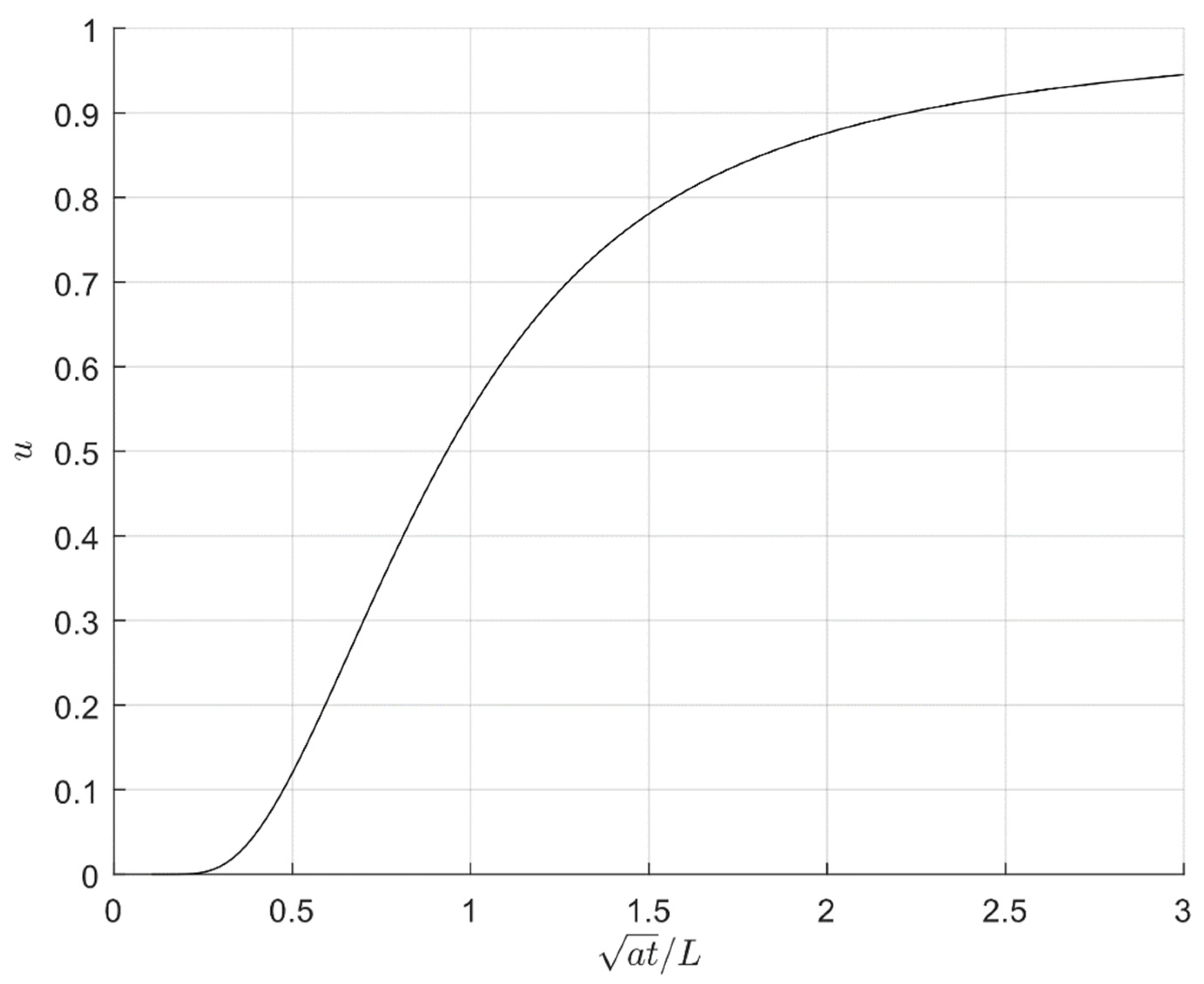
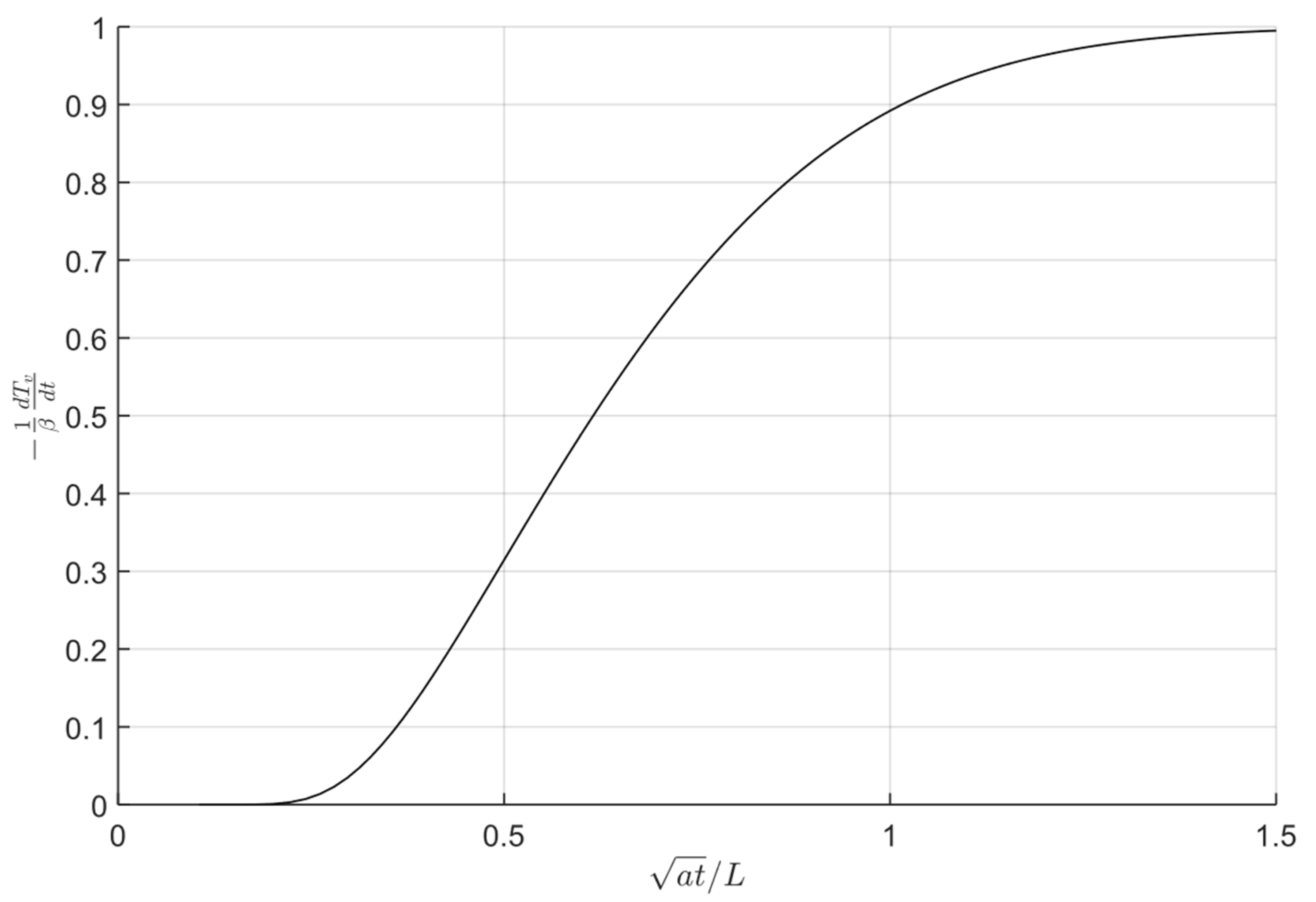
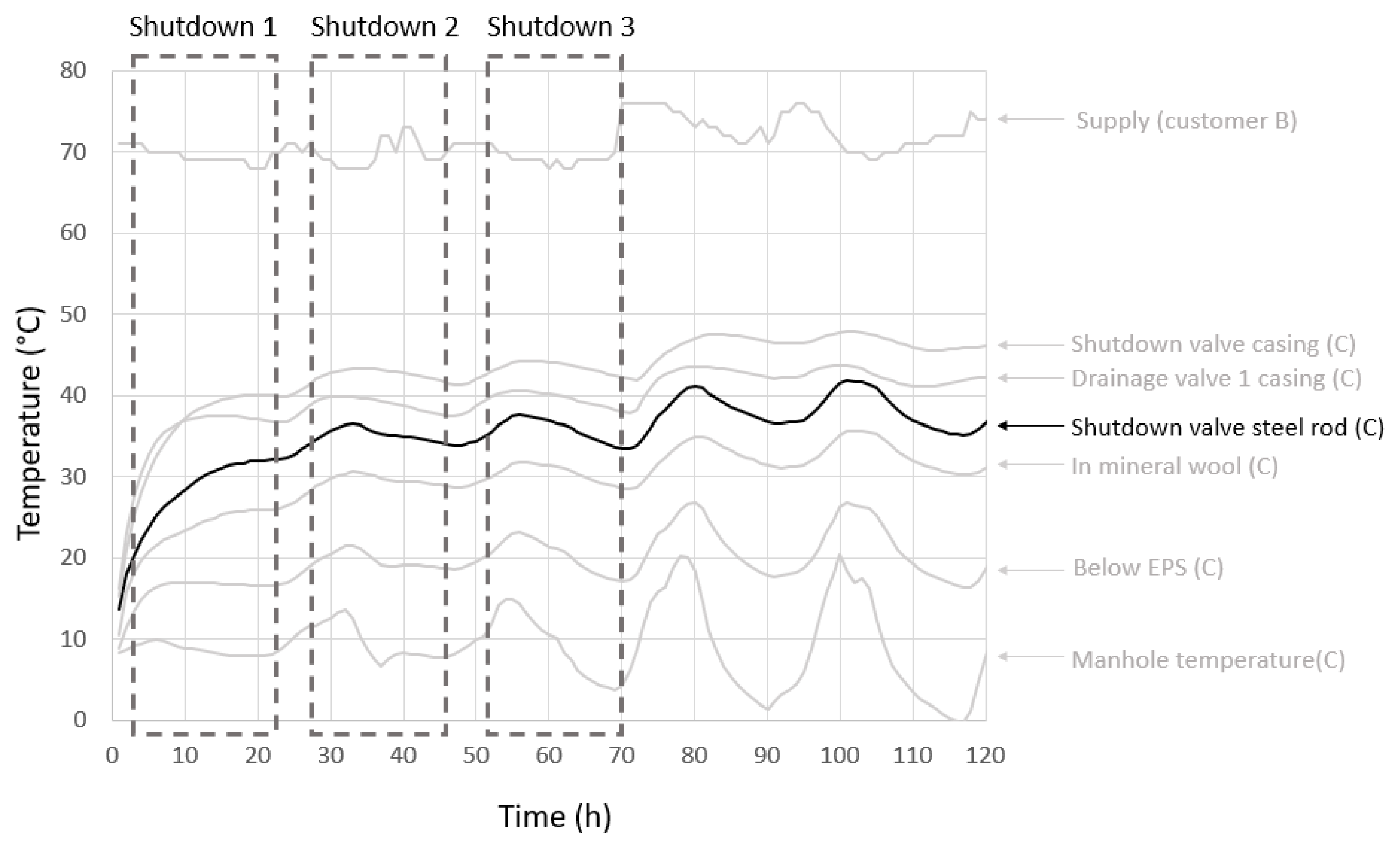
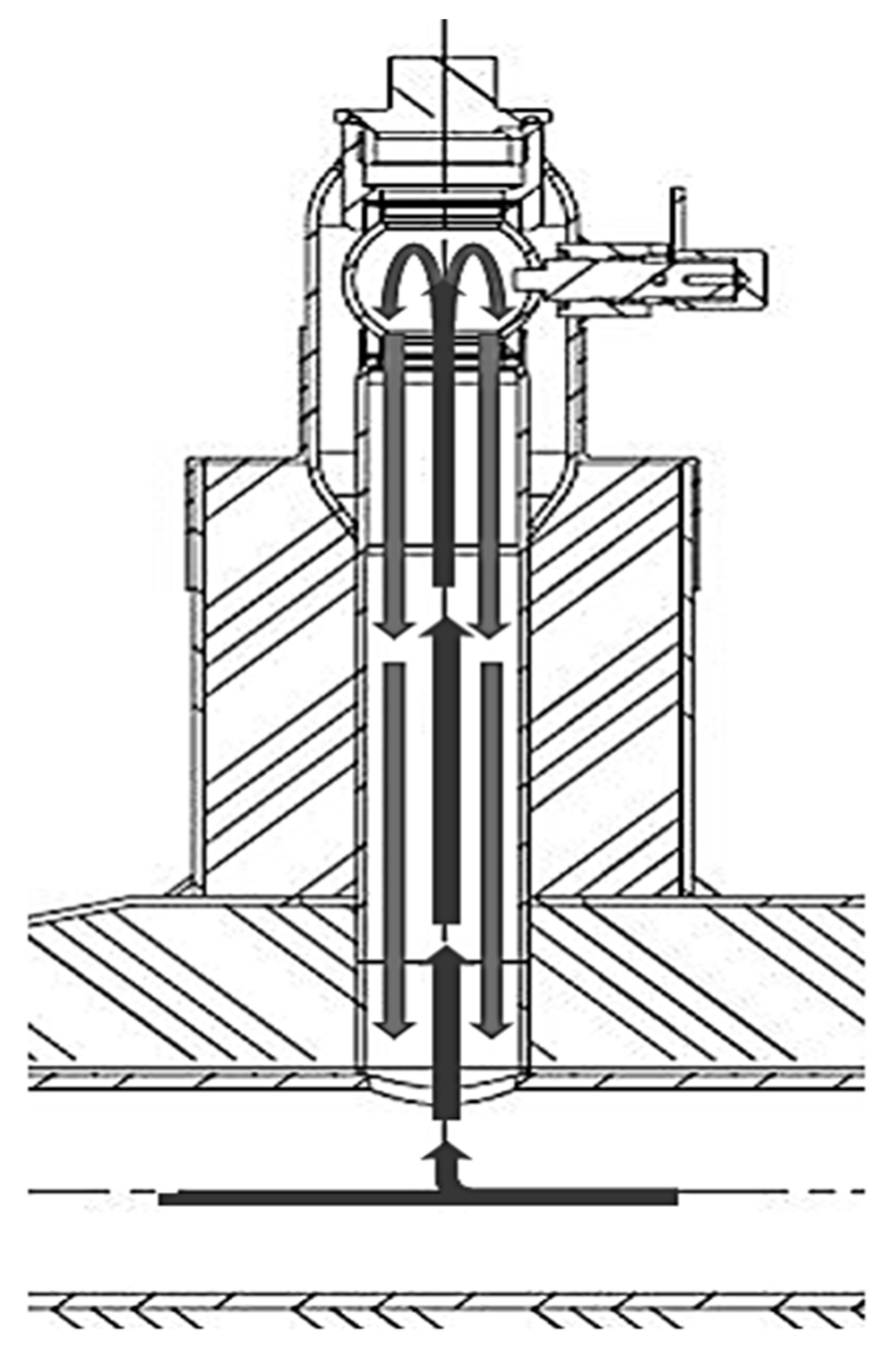

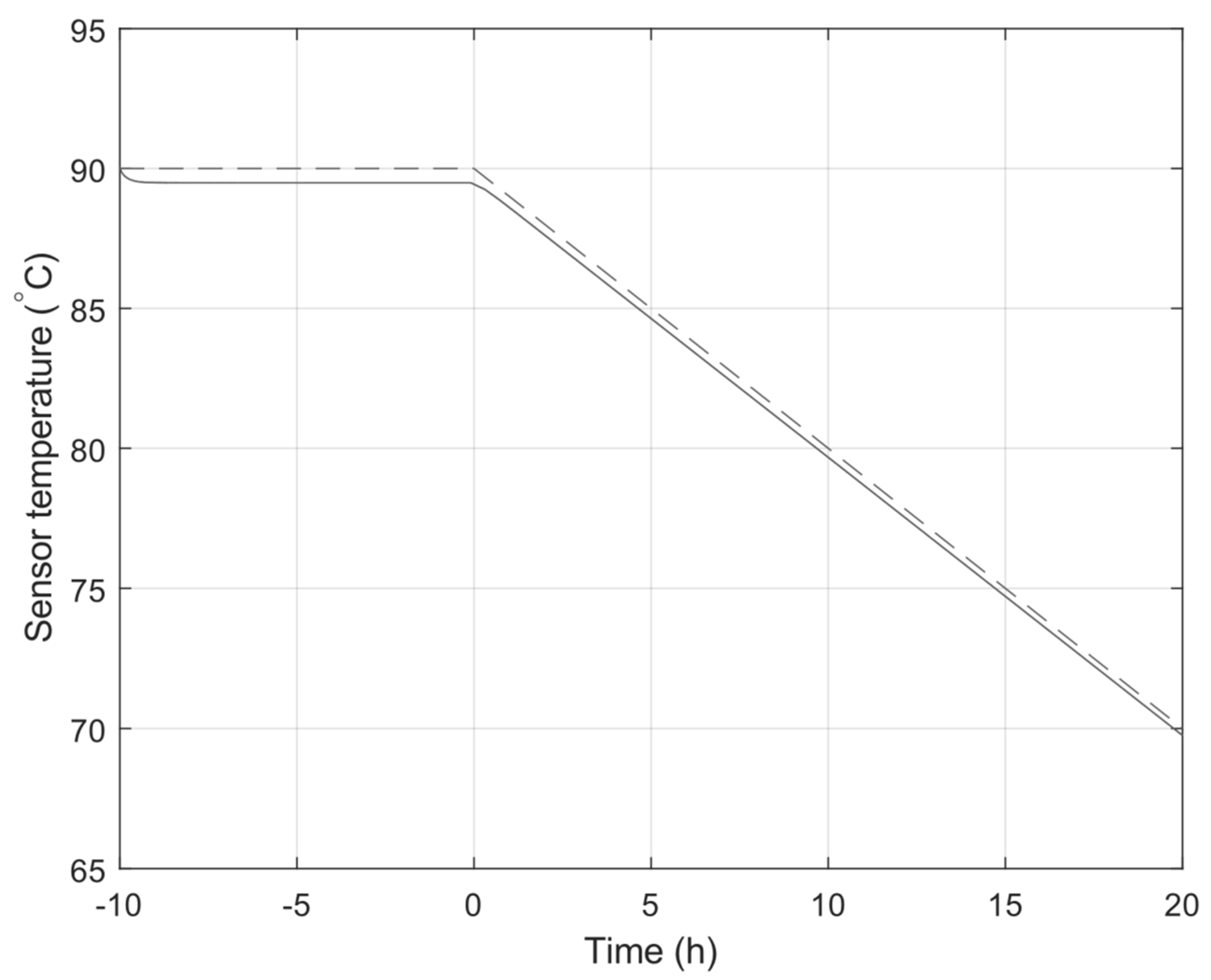
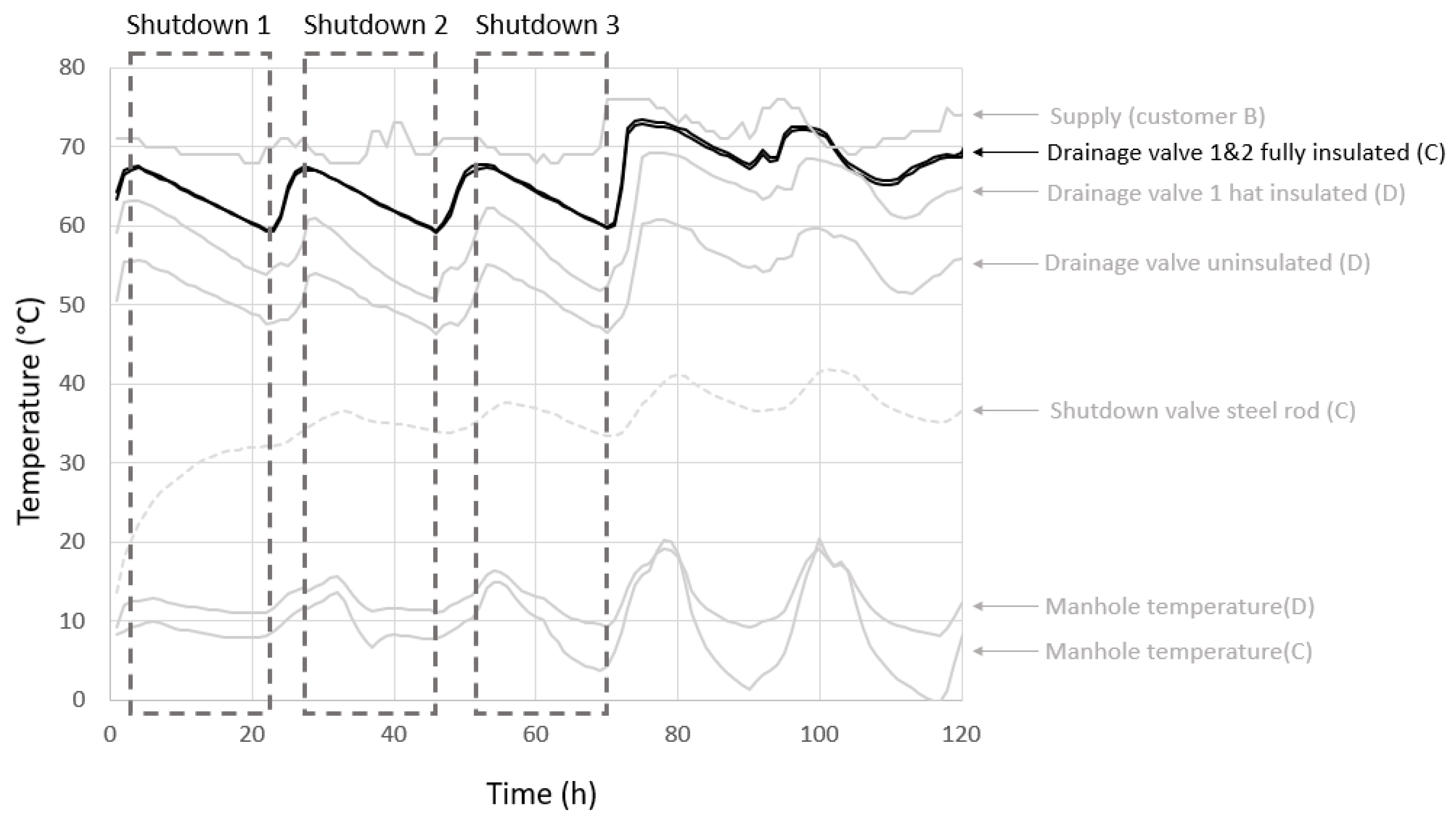
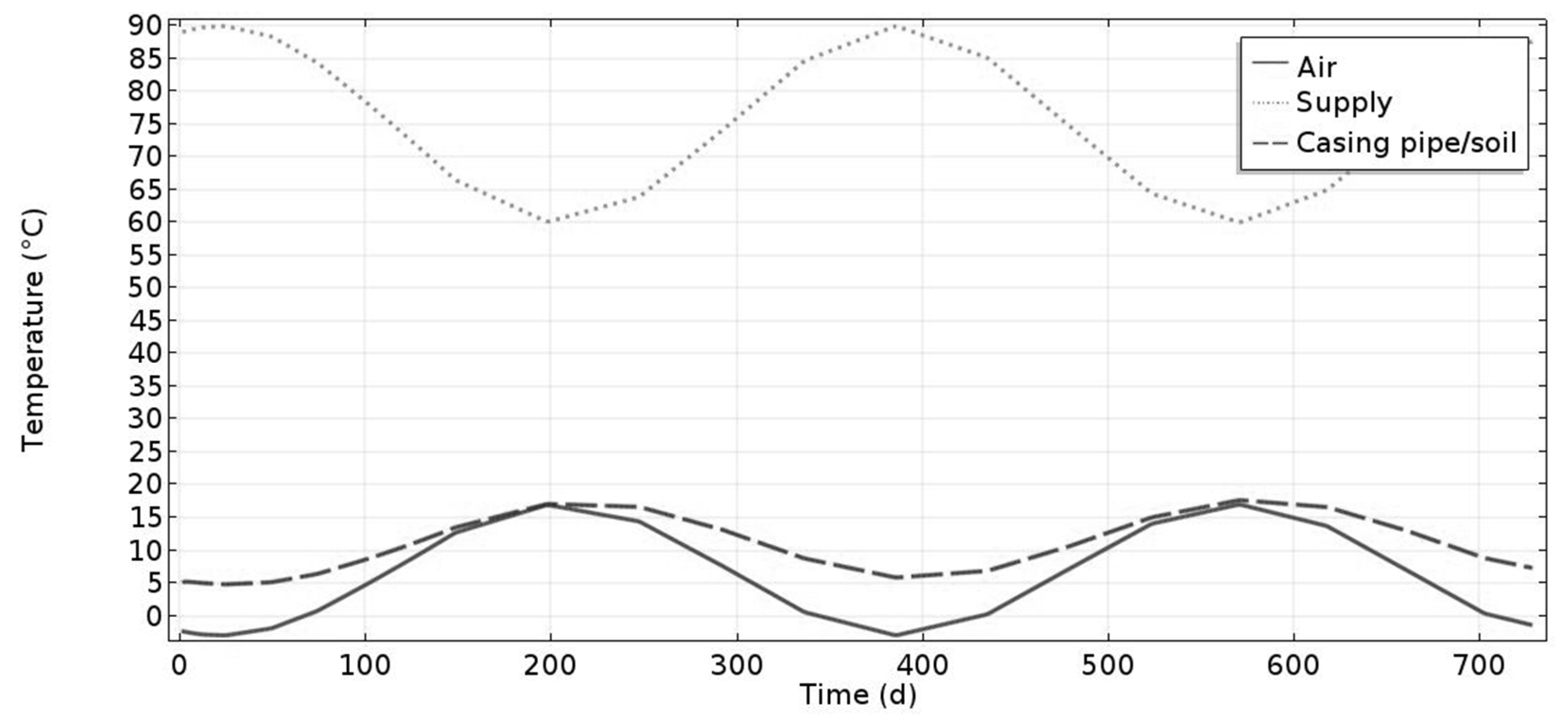
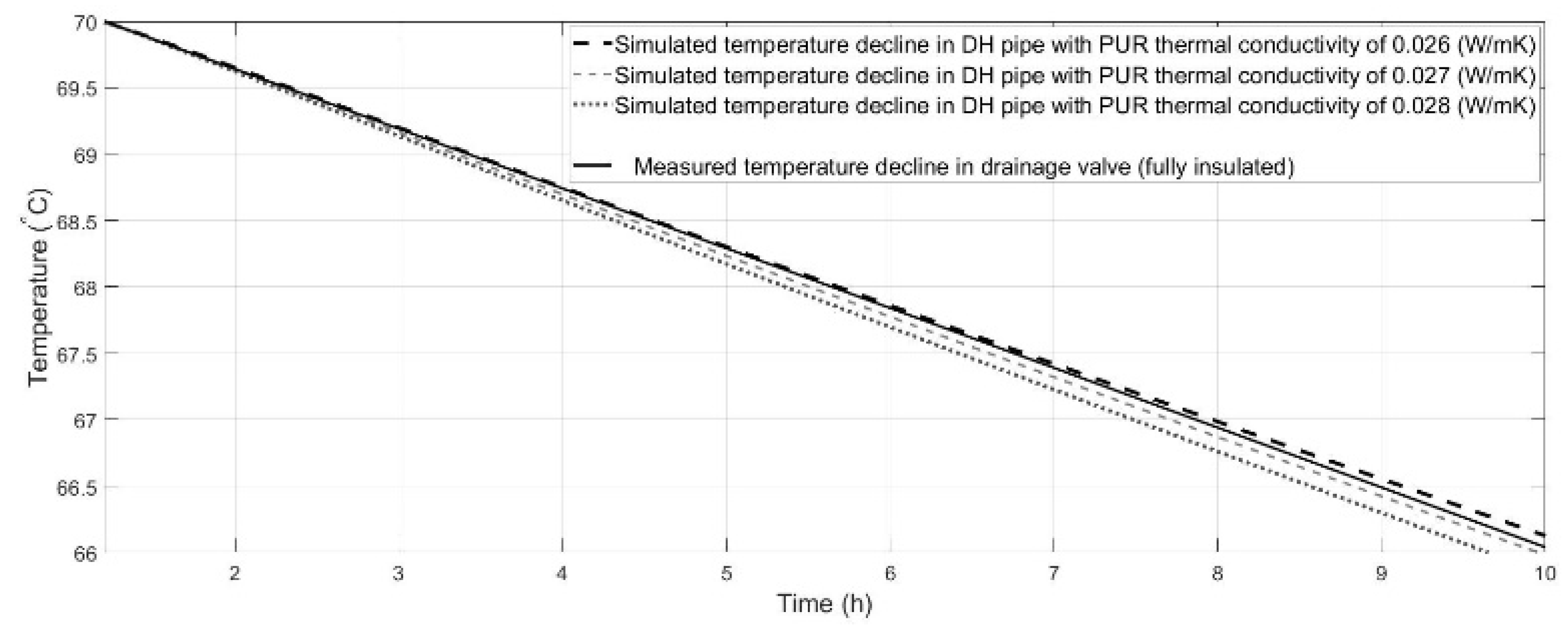
| Shutdown Valve, Hat Insulated | Shutdown Valve, Fully Insulated | |
|---|---|---|
| Matching factor | 0.71 | 0.53 |
| Standard deviation | 0.28 | 0.05 |
| Shutdown Valve, Hat Insulated | Thermal Response Time (min) | Temperature Decline (°C/h) | Shutdown Valve, Fully Insulated | Thermal Response Time (min) | Temperature Decline (°C/h) |
|---|---|---|---|---|---|
| First shutdown | 510 | 0.37 | First shutdown | - | - |
| Second shutdown | 337 | 0.44 | Second shutdown | 352 | 0.17 |
| Third shutdown | 270 | 0.33 | Third shutdown | 263 | 0.29 |
| Drainage Valve, Uninsulated | Drainage Valve, Hat Insulated | Drainage Valve, Fully Insulated | |
|---|---|---|---|
| Matching factor | 0.28 | 0.12 | 0.05 |
| Standard deviation | 0.04 | 0.06 | 0.03 |
| Drainage Valve, Hat Insulated | Thermal Response Time (min) | Temperature Decline (°C/h) | Drainage Valve, Fully Insulated | Thermal Response Time (min) | Temperature Decline (°C/h) |
|---|---|---|---|---|---|
| First shutdown | 70 | 0.43 | First shutdown | 41 | 0.45 |
| Second shutdown | 43 | 0.45 | Second shutdown | 45 | 0.44 |
| Third shutdown | 33 | 0.44 | Third shutdown | 54 | 0.46 |
Publisher’s Note: MDPI stays neutral with regard to jurisdictional claims in published maps and institutional affiliations. |
© 2021 by the authors. Licensee MDPI, Basel, Switzerland. This article is an open access article distributed under the terms and conditions of the Creative Commons Attribution (CC BY) license (https://creativecommons.org/licenses/by/4.0/).
Share and Cite
Lidén, P.; Adl-Zarrabi, B.; Hagentoft, C.-E. Diagnostic Protocol for Thermal Performance of District Heating Pipes in Operation. Part 2: Estimation of Present Thermal Conductivity in Aged Pipe Insulation. Energies 2021, 14, 5302. https://doi.org/10.3390/en14175302
Lidén P, Adl-Zarrabi B, Hagentoft C-E. Diagnostic Protocol for Thermal Performance of District Heating Pipes in Operation. Part 2: Estimation of Present Thermal Conductivity in Aged Pipe Insulation. Energies. 2021; 14(17):5302. https://doi.org/10.3390/en14175302
Chicago/Turabian StyleLidén, Peter, Bijan Adl-Zarrabi, and Carl-Eric Hagentoft. 2021. "Diagnostic Protocol for Thermal Performance of District Heating Pipes in Operation. Part 2: Estimation of Present Thermal Conductivity in Aged Pipe Insulation" Energies 14, no. 17: 5302. https://doi.org/10.3390/en14175302
APA StyleLidén, P., Adl-Zarrabi, B., & Hagentoft, C.-E. (2021). Diagnostic Protocol for Thermal Performance of District Heating Pipes in Operation. Part 2: Estimation of Present Thermal Conductivity in Aged Pipe Insulation. Energies, 14(17), 5302. https://doi.org/10.3390/en14175302






